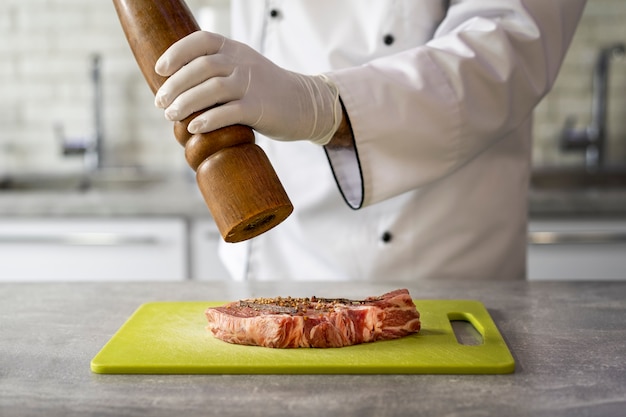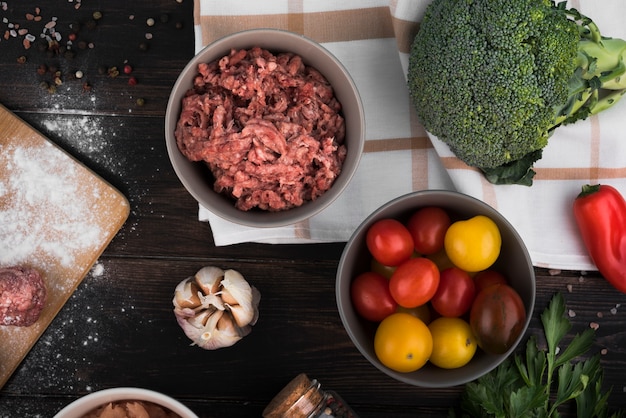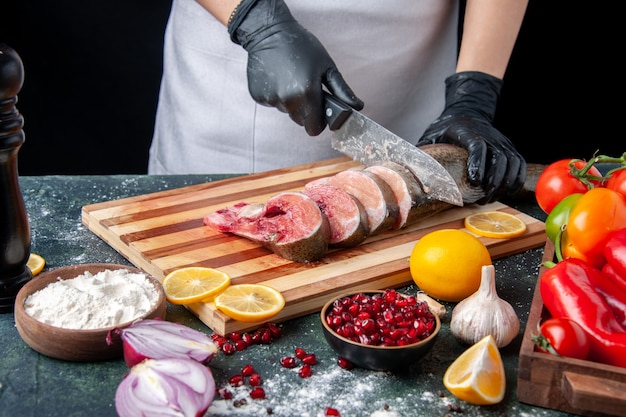(Part 1) Understanding the Porterhouse

What Makes a Porterhouse Special?
Firstly, let's talk about the star of the show – the Porterhouse steak. Now, you might be wondering, what makes this cut of meat so special? Well, the Porterhouse is actually a combination of two different cuts: the tenderloin and the strip steak. That's why you see that lovely, thick, T-shaped bone sticking out. The tenderloin side, also known as the filet mignon, is known for its incredible tenderness and leanness, while the strip steak side offers a bit more flavour and chewiness. This combination of textures and flavours is what makes the Porterhouse so unique and satisfying.
Where Does it Come From?
Now, you're probably thinking, "This sounds amazing! Where can I find this magical cut of meat?" Well, you'll usually find Porterhouse steaks from cattle that have been raised specifically for their meat quality. Think of it like the top tier of beef, with those rich marbling patterns that make the meat so juicy and flavorful. The best Porterhouses come from cuts like Angus, Wagyu, and Hereford breeds. You'll typically find them at your local butcher or in the meat department of a good supermarket. Some butchers may even have special cuts available, like dry-aged Porterhouses, which have a more intense flavour and tender texture.
The Porterhouse vs. the T-Bone
So, you've got your Porterhouse, but what about the T-bone steak? Are they the same thing? Well, they are actually quite similar. Both cuts have that characteristic T-shaped bone, and both are a combination of tenderloin and strip steak. However, the main difference lies in the size and proportion of the two cuts. A Porterhouse steak will have a larger tenderloin portion compared to the strip, while a T-bone steak will have a smaller tenderloin and a larger strip steak portion. So, essentially, a Porterhouse is just a bigger, more generous version of the T-bone.
If you're looking for a truly luxurious steak experience, the Porterhouse is the way to go. But if you're on a budget or just want a smaller portion, a T-bone steak is a great alternative.
(Part 2) Choosing the Perfect Porterhouse

Grade and Marbling
You know that saying, "You get what you pay for?" Well, it applies to Porterhouse steaks too. Look for a steak with a good amount of marbling – those tiny, white streaks of fat within the meat. Marbling is your friend, folks, because it makes the steak juicy, flavorful, and tender. The fat melts during cooking, adding moisture and flavour to the meat. The more marbling, the richer and more flavourful the steak will be. Aim for a steak that has at least "Select" grade or higher, but if you want the real deal, go for "Choice" or even "Prime." "Prime" grade is the highest grade of beef available, and it's known for its exceptional marbling and flavour. If you can find a Porterhouse steak with "Prime" grading, you're in for a real treat. But, remember, the higher the grade, the more expensive it will be.
The Size Matters
Next, let's talk about size. Now, you want a steak that's thick enough to cook evenly and create a juicy, flavorful centre. Aim for a steak that's at least 1.5 inches thick, and up to 2 inches if you really want to go all out. A thicker steak will take longer to cook, but it will also hold its moisture better and result in a more tender, juicy centre. You can always get a larger steak and cut it into smaller portions later, but don't go too thin. A thin steak will cook too quickly and may end up dry and tough.
A Few Things to Look For
Now, you've got your hands on a nice thick Porterhouse. Here are a few things to check before you head to the checkout:
- The colour: Look for a steak that has a deep, rich red colour. Avoid anything that looks pale or has a dull, brown hue. A pale colour can indicate that the steak has been exposed to light for too long or that it's not fresh.
- The texture: The steak should feel firm and springy to the touch. Avoid anything that feels slimy or mushy. A slimy or mushy texture is a sign that the steak has gone bad.
- The smell: A fresh Porterhouse steak should have a pleasant, earthy aroma. If it smells sour or ammonia-like, that's a sign it's gone bad.
(Part 3) Prepping Your Porterhouse

Room Temperature, Please
Right, your Porterhouse is ready to go, but before you even think about firing up the grill, you need to let it come to room temperature. Now, I know what you're thinking: "Room temperature? That seems risky!" But trust me on this one. A cold steak will cook unevenly and won't sear properly. By letting it sit out for 30-60 minutes, the internal temperature will even out, and it will cook more consistently. Just make sure to keep it covered in the fridge until you're ready to cook. This will prevent bacteria from growing and keep your steak safe to eat.
Seasoning is Key
Now, you've got a warm, beautiful Porterhouse. Time to season it! I like to keep things simple with salt and freshly ground black pepper. That's all you really need to let the natural flavour of the steak shine through. A good quality sea salt and freshly ground black pepper will bring out the natural flavours of the steak without overpowering them. But if you want to go a little crazy, try adding some garlic powder, onion powder, paprika, or even a pinch of cayenne pepper. Just remember, a little goes a long way! And don't be afraid to experiment and find your own favourite seasoning blend. Perhaps you'd like a touch of smoked paprika for a smoky depth or a sprinkle of herbs for a fresh and aromatic flavour. The possibilities are endless!
Get Rid of the Excess
Now, you've got your seasoned steak, but there's one more thing you need to do: pat it dry. This step is crucial, because moisture on the surface of the steak will prevent a nice, crisp sear. Use paper towels to gently pat the entire surface of the steak until it's completely dry. This will ensure that the steak sears properly and develops a beautiful crust.
(Part 4) Grilling to Perfection
Get Your Grill Ready
Right, the big moment is here – grilling time! Make sure your grill is nice and hot. I'm talking about medium-high heat, around 450-550°F. You want those grill grates searing hot for a beautiful crust. If you're using a gas grill, preheat for 10-15 minutes. For a charcoal grill, use about 10-12 coals, making sure they are evenly distributed across the grill surface. The coals should be glowing red-hot, with a layer of white ash. Remember, you're aiming for a nice, even heat. You can also use a grill brush to clean the grates before cooking. Nothing worse than sticking food to a dirty grill, trust me.
Time for the Sear
Okay, it's go time. Carefully place your Porterhouse steak on the hot grill grates. Resist the urge to press down on the steak! You want it to cook evenly without any uneven pressure. Let the steak cook undisturbed for about 3-4 minutes per side, or until it develops a nice crust. The sear will help to lock in the juices and give the steak a beautiful flavour. You can also use a meat thermometer to check the temperature. For a medium-rare steak, you want an internal temperature of 130-135°F. For a medium steak, aim for 140-145°F. And for a medium-well steak, go for 150-155°F.
Flip It Like It's Hot
Now, after about 3-4 minutes, it's time to flip the steak. You want to get a beautiful sear on both sides. Don't worry if it sticks a little at first, just give it a gentle nudge and it will release. Keep flipping the steak every 3-4 minutes until it reaches your desired level of doneness. As the steak cooks, you'll notice the juices rising to the surface. This is a good sign that the steak is cooking properly.
The Importance of Resting
After you've grilled your steak to perfection, it's time to let it rest. I know, I know, you're probably dying to dig in, but resist the temptation! Let the steak rest on a cutting board for 10-15 minutes. This allows the juices to redistribute evenly throughout the meat, resulting in a juicier, more flavorful steak. You can also cover the steak loosely with foil to keep it warm while it rests. This step is crucial for ensuring a tender, juicy steak. You can use the resting time to prepare your sides and sauces.
(Part 5) Alternative Cooking Methods
The Pan-Seared Method
While grilling is definitely the classic method for cooking a Porterhouse, there are other ways to achieve delicious results. If you don't have a grill, or just prefer a more controlled cooking method, pan-searing is a great option. Simply heat a heavy-bottomed skillet over medium-high heat. A cast iron skillet is ideal for pan-searing because it retains heat well and creates a beautiful crust. Add a tablespoon or two of oil to the pan, and allow it to heat up. Once the oil is shimmering, carefully place the Porterhouse steak in the pan. Don't crowd the pan – you want the steak to have enough space to sear properly. If you have a large steak, you may need to cook it in two batches.
Let the steak cook for about 3-4 minutes per side, or until it develops a nice, golden brown crust. You can use a meat thermometer to check the internal temperature, just like you would with a grill. Once the steak has reached your desired level of doneness, remove it from the pan and let it rest for 10-15 minutes. The resting time will allow the juices to redistribute, resulting in a more tender and flavorful steak.
Oven-Roasted Goodness
If you prefer a more hands-off approach, oven-roasting can be a great option. Preheat your oven to 400°F. Place your seasoned Porterhouse steak on a baking sheet, making sure it's not touching the sides of the pan. Roast the steak for about 10-15 minutes per side, or until it reaches your desired level of doneness. You can use a meat thermometer to check the internal temperature. Be careful when handling the hot baking sheet. Once the steak is cooked, remove it from the oven and let it rest for 10-15 minutes.
The reverse sear Technique
Now, here's a technique that's gaining popularity, and for good reason: the reverse sear. This method involves cooking the steak at a lower temperature for a longer period of time, followed by a quick sear over high heat. This results in a steak that's cooked evenly throughout, with a juicy centre and a delicious crust. The lower temperature cooking ensures that the steak is cooked to the desired doneness throughout, while the quick sear at the end adds a crispy exterior.
Preheat your oven to 275°F. Place the seasoned Porterhouse steak on a baking sheet and roast for about 30-45 minutes, or until the internal temperature reaches about 125°F for a medium-rare steak. Use a meat thermometer to check the internal temperature. Once the steak is cooked, remove it from the oven and let it rest for 10-15 minutes. Then, heat a heavy-bottomed skillet over high heat and sear the steak for about 1 minute per side, or until it develops a nice crust. This quick sear will lock in the juices and give the steak a beautiful caramelized finish.
(Part 6) Sauces and Sides
Perfect Pairings
Right, your Porterhouse steak is cooked to perfection, but what about the accompaniments? There are so many delicious sauces and sides that pair perfectly with this meaty masterpiece. Here are a few of my favorites:
For sauces, I love a classic béarnaise sauce or a rich, creamy peppercorn sauce. Both of these sauces complement the steak beautifully, adding a touch of richness and complexity. Béarnaise sauce, with its tangy flavour and creamy texture, is a classic pairing for steak. Peppercorn sauce, with its spicy kick and creamy base, adds a depth of flavour to the steak. But if you're feeling adventurous, try a chimichurri sauce or a vibrant salsa verde. These sauces bring a burst of fresh flavour and zest to the steak, making it feel light and refreshing. Chimichurri sauce, with its blend of herbs and spices, adds a bright and herbaceous flavour to the steak. Salsa verde, with its combination of herbs, green peppers, and a tangy citrus base, offers a vibrant and refreshing flavour profile.
For sides, I'm a big fan of roasted vegetables, like asparagus, broccoli, or Brussels sprouts. These vegetables have a nice char and a slightly sweet flavour that balances out the richness of the steak. You can also try a simple salad with a tangy vinaigrette dressing, or creamy mashed potatoes. For a more hearty option, try a potato gratin or a side of mac and cheese. The possibilities are truly endless!
Remember, the key to a successful meal is to choose sides that complement the flavour of the steak and create a balanced and satisfying experience. Don't be afraid to experiment with different combinations to find your favourites.
(Part 7) FAQs
1. How long do I cook a Porterhouse steak?
The cooking time for a Porterhouse steak will depend on the thickness of the steak and your desired level of doneness. For a 1.5-inch thick steak, expect to cook it for about 10-12 minutes total, flipping it halfway through. A thicker steak will require a longer cooking time. Always use a meat thermometer to check the internal temperature for accuracy.
Here's a general guide for cooking times:
| Doneness | Internal Temperature (°F) | Approximate Cooking Time (per side) |
|---|---|---|
| Rare | 125-130 | 3-4 minutes |
| Medium-Rare | 130-135 | 4-5 minutes |
| Medium | 140-145 | 5-6 minutes |
| Medium-Well | 150-155 | 6-7 minutes |
| Well-Done | 160+ | 8+ minutes |
2. Can I cook a Porterhouse steak in a cast iron skillet?
Absolutely! A cast iron skillet is a great option for pan-searing a porterhouse steak. Just make sure to preheat the skillet over medium-high heat and add a tablespoon or two of oil before adding the steak. Let the steak cook for 3-4 minutes per side, or until it develops a nice crust. You can also use a meat thermometer to check the internal temperature. A cast iron skillet can retain heat well, creating a beautiful sear on the steak. It's also very versatile and can be used on the stovetop or in the oven.
3. How can I tell if a Porterhouse steak is done?
The best way to determine if a Porterhouse steak is done is to use a meat thermometer. Insert the thermometer into the thickest part of the steak, making sure it's not touching bone or fat. For a medium-rare steak, aim for an internal temperature of 130-135°F. For a medium steak, go for 140-145°F. And for a medium-well steak, aim for 150-155°F. You can also use the touch test, but this is less accurate. Press your finger into the centre of the steak. If it feels soft and springy, it's rare. If it feels firm but still has some give, it's medium-rare. If it feels firm and almost rubbery, it's well-done.
4. What are the best cuts of meat for a Porterhouse steak?
The best cuts of meat for a Porterhouse steak are typically Angus, Wagyu, and Hereford breeds. These breeds are known for their rich marbling, which makes the steak incredibly juicy and flavorful. You can also find Porterhouse steaks from other breeds, but the quality will vary. Always ask your butcher for their recommendations. They'll be able to advise you on the best cuts of meat available based on your budget and preferences.
5. What's the best way to reheat a Porterhouse steak?
The best way to reheat a Porterhouse steak is to use a low and slow approach. Preheat your oven to 275°F. Place the steak on a baking sheet and roast for about 15-20 minutes, or until it's heated through. You can also reheat the steak in a skillet over medium heat for about 5-7 minutes per side, or until it's heated through. Avoid microwaving the steak, as this can dry it out and make it tough. Microwaving can cook the steak unevenly and result in a tough texture.
(Part 8) Conclusion
There you have it – your complete guide to cooking the perfect Porterhouse steak. From choosing the right cut of meat to grilling, pan-searing, or roasting it to perfection, you now have all the knowledge you need to impress your family and friends with a delicious and unforgettable meal. So next time you're craving a truly special steak, remember these tips and tricks, and get ready for a culinary adventure. Happy grilling!
Everyone is watching

How to Cook Frozen Lobster Tails Perfectly: A Step-by-Step Guide
RecipesLobster. Just the word conjures up images of lavish meals, special occasions, and a taste of luxury. But let's...

Pigs in a Blanket Cooking Time: How Long to Bake for Perfect Results
RecipesAh, pigs in a blanket. Just the name conjures up images of those delightful little parcels of crispy pastry en...

Pork Fillet Cooking Time: How Long to Cook It Perfectly
RecipesPork fillet, or tenderloin as it's sometimes called, is a real favourite in our house. It's so versatile, and...

The Ultimate Guide to Tender, Juicy Pulled Pork
RecipesRight, let's talk pulled pork. It's one of those dishes that just screams "comfort food," doesn't it? I mean...

The Ultimate Guide to Cooking Delicious Frankfurters
RecipesLet's face it, we all love a good frankfurter. It's a classic, simple, and always satisfying. But let's be rea...
